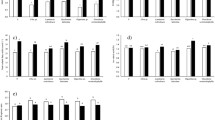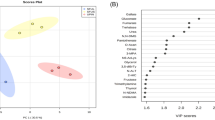Abstract
Feeding seaweeds and macroalgal products has been shown to reduce enteric methane emission from rumen fermentation. On Prince Edward Island, Canada, stormtoss shoreweed (SHW) consists of variable seaweed proportions of Chondrus crispus (Irish moss; IM), Laminaria longicruris, and Fucus vesiculosus. The impact of invasion by Furcellaria spp. (FF) and its increasing proportion in SHW harvests on feeding value has not been evaluated. The aim of this study was to determine effects of feeding SHW on ruminal fermentation and methane production. Effects were assessed in vitro using continuous culture with pooled rumen inocula from Holstein cows. In vitro cultures were maintained on 30 g day−1 of the dietary dry matter (DM) fed to donor cows and were supplemented with FF or IM at 0.14, or SHW at 0.14 (SHW1), 0.28 (SHW2), or 0.56 (SHW3) g DM day−1. There was little change in pH, total volatile fatty acids, or the acetate/propionate ratio due to seaweeds. The SHW mix and component seaweeds reduced the post-fermentation level of NH3-N suggesting decreased deamination of dietary and microbial amino acids. Methane emission was reduced on average 12 % with seaweeds and maximally by 16 % with SHW2. Reduction in methane production was not induced by impaired organic matter (OM) digestibility which averaged 46 %. North Atlantic SHW has potential based on in vitro screening at these doses to be fed to ruminants with beneficial effects on methane production at little cost to dietary digestibility.
Similar content being viewed by others
References
Beauchemin KA, McGinn SM, Grainger C (2008) Reducing methane emissions from dairy cows. WCDS Adv Dairy Technol 20:79–93
Bergman EN (1990) Energy contributions of volatile fatty acids from the gastrointestinal tract in various species. Physiol Rev 70:567–590
Berzaghi P, Herbein JH, Polan CE (1996) Intake, site, and extent of nutrient digestion of lactating cows grazing pasture. J Dairy Sci 79:1581–1589
Bird CJ, Greenwell M, McLachlan J (1983) Benthic marine algal flora of the north shore of Prince Edward Island (Gulf of St. Lawrence), Canada. Aquat Bot 16:315–335
Blunt JW, Copp BR, Keyzers RA, Munro MH, Prinsep MR (2013) Marine natural products. Nat Prod Rep 30:237–323
CCAC (Canadian Council on animal Care) (2009) CCAC guidelines on: the care and use of farm animals in research, teaching, and testing. CCAC, Ottawa, http://www.ccac.ca/Documents/Standards/Guidelines/Farm_Animals.pdf
Chenost M, Aufrére J, Macheboeuf D (2001) The gas-test technique as a tool for predicting the energetic value of forage plants. Anim Res 50:349–364
Clesceri LS, Greenberg AE, Eaton AD (eds) (1998) Standard methods for the examination of water and waste water. 20th edn. Amercian Public Health Association (APHA). Washington, DC
Cone JW, van Gelder AH (1999) Influence of protein fermentation on gas production profiles. Anim Feed Sci Technol 76:251–264
Cox S, Abu-Ghannam N, Gupta S (2010) An assessment of the antioxidant and antimicrobial activity of six species of edible Irish seaweeds. Int Food Res J 17:205–220
Craig MW, Broderick GA, Ricker DB (1987) Quantitation of microorganisms associated with the particulate phase of ruminal ingesta. J Nutr 117:56–62
Craigie JS (2011) Seaweed extract stimuli in plant science and agriculture. J Appl Phycol 23:371–393
Doty MS, Caddy JF, Santelices B (eds) (1987) Case study of seven commercial seaweed resources. Chondrus crispus Stackhouse. Section 5.0. FAO Fish. Tech Pap T281, pp 311
Dubois B, Tomkins NW, Kinley RD, Bai M, Seymour S, Paul NA, de Nys R (2013) Effect of tropical algae as additives on rumen in vitro gas production and fermentation characteristics. Am J Plant Sci 4:34–43
Duffield T, Plaizier JC, Fairfield A, Bagg R, Vessie G, Dick P, Wilson J, Aramini J, McBride B (2004) Comparison of techniques for measurement of rumen pH in lactating dairy cows. J Dairy Sci 87:59–66
Dunlop G (1953) Feeding of seaweed meal to lactating cows. Nature 171:439–440
Evans FD, Critchley AT (2014) Seaweeds for animal production use. J Appl Phycol 26:891–899
García V, Catalá-Gregori P, Madrid J, Hernández F, Megías MD, Andrade-Montemayor HM (2007) Potential of carvacrol to modify in vitro rumen fermentation as compared with monensin. Animal 1:675–680
Holdt SL, Kraan S (2011) Bioactive compounds in seaweed: functional food applications and legislation. J Appl Phycol 23:543–597
Horwitz W (ed) (2000) Official methods of AOAC international. 17th edn. Association of Official Analytical Chemists (AOAC) International. Gaithersburg
Lee SH, Jeon YJ (2013) Anti-diabetic effects of brown algae derived phlorotannins, marine polyphenols through diverse mechanisms. Fitoterapia 86:129–136
Machado L, Kinley RD, Magnusson M, de Nys R, Tomkins NW (2014a) The potential of macroalgae for beef production systems in Northern Australia. J Appl Phycol. doi:10.1007/s10811-014-0439-7
Machado L, Magnusson M, Paul NA, de Nys R, Tomkins N (2014b) Effects of marine and freshwater macroalgae on in vitro total gas and methane production. PLoS One 9(1):e85289
Madrid J, Megías MD, Hernández F (1999) Determination of short chain volatile fatty acids in silages from artichoke and orange by-products by capillary gas chromatography. J Sci Food Agric 79:580–584
Mathieson AC, Pederson JR, Neefus CD, Dawes CJ, Bray TL (2008) Multiple assessments of introduced seaweeds in the Northwest Atlantic. ICES J Mar Sci 65:730–741
Menke KH, Raab L, Salewski A, Steingass H, Fritz D, Schneider W (1979) The estimation of the digestibility and metabolizable energy content of ruminant feeding stuffs from the gas production when they are incubated with rumen liquor in vitro. J Agric Sci 93:217–222
Mueller-Harvey I (2006) Unraveling the conundrum of tannins in animal nutrition and health. J Sci Food Agric 86:2010–2037
Muetzel S, Lawrence P, Hoffmann EM, Becker K (2009) Evaluation of a stratified continuous rumen incubation system. Anim Feed Sci Technol 151:32–43
NRC (National Research Council) (2001) Nutrient requirements of dairy cattle, 7th edn. National Academy of Sciences, Washington, DC
Owens FN, Secrist DS, Hill WJ, Gill DR (1998) Acidosis in cattle: a review. J Anim Sci 76:275–286
Paul NA, de Nys R, Steinberg PD (2006) Chemical defence against bacteria in the red alga Asparagopsis armata: linking structure with function. Mar Ecol Prog Ser 306:87–101
Sharp GJ, Têtu C, Semple R, Jones D (1993) Recent changes in the seaweed community of Western Prince Edward Island: implications for the seaweed industry. Hydrobiologia 260(261):291–296
Teather RM, Sauer FD (1988) A naturally compartmented rumen simulation system for the continuous culture of rumen bacteria and protozoa. J Dairy Sci 71:666–673
VSN International (2006) GenStat Release 12.1 statistical software. VSN International Limited, Hemel Hempstead
Wang Y, Xu Z, Bach SJ, McAllister TA (2008) Effects of phlorotannins from Ascophyllum nodosum (brown seaweed) on in vitro ruminal digestion of mixed forage or barley grain. Anim Feed Sci Technol 145:375–395
Acknowledgments
This study was completed at the Dalhousie University Agricultural Campus (Dal-AC) in Truro, Nova Scotia, Canada. The authors thank Elizabeth Gnemmi and the Dal-AC Ruminant Animal Center, Joe Dorgan (North Atlantic Organics), and Mark Grimmitt (Agriculture Canada) for their input into this study. This study was made possible by grants from the Prince Edward Island Adapt Council and North Atlantic Organics, PEI, Canada.
Author information
Authors and Affiliations
Corresponding author
Rights and permissions
About this article
Cite this article
Kinley, R.D., Fredeen, A.H. In vitro evaluation of feeding North Atlantic stormtoss seaweeds on ruminal digestion. J Appl Phycol 27, 2387–2393 (2015). https://doi.org/10.1007/s10811-014-0487-z
Received:
Revised:
Accepted:
Published:
Issue Date:
DOI: https://doi.org/10.1007/s10811-014-0487-z




